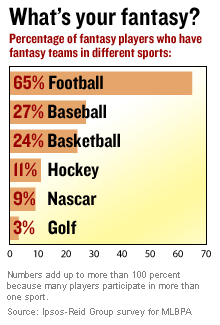
NEW YORK (CNN/Money) -
Forget who wins Thursday's kickoff of the 2003-2004 football season. For many fans, the makeup of their fantasy football teams, which will be chosen in the next week, will be a much bigger deal.
For those not among the estimated 15 million fantasy sports players, the idea is to select a group of real players for a fictional team, then use the real-life statistics of those players to determine which team in a fantasy league is doing the best. And as part of the league fee, there generally is a modest prize pool to be split by the top teams at the end of the season.

Fantasy sports started with a baseball league in 1980, with fantasy owners compiling weekly stats with various sports newspapers, such as Sporting News.
The birth of the Internet gave rise to services that would quickly crunch the stats and send out standings via e-mail or post them on a Web site, giving the games explosive double-digit growth through most of the 1990s.
Despite its baseball roots, fantasy football has become the most popular version of the sport, with about 10 million participants according to one survey. That's slightly above the average number of households tuned into NFL games on CBS on an average Sunday last season.
Gaining fans -- and profits
What is new is that most of the stat services have finally started making money. Sports sites on the Web and fantasy services finally started charging players. And lo and behold, millions of fantasy players started to pay, without much objection.
"The industry has finally realized people are willing to pay for stat service and the content if it's good enough," said Greg Ambrosius, president of Fantasy Sports Trade Association and editor of some of the fantasy draft guides. "No doubt the industry is much more stable business-wise because pay service has returned."
| Related Stories
|

|
|
|
|
The free services found across the Internet in much of the 1990s have basically disappeared, Ambrosius said. Yahoo! is one of the only major free services still available, and even it offers premium services for leagues or individual team owners to add onto.
SportsLine.com (SPLN: Research, Estimates), the only stand-alone publicly traded sports site with more than 80,000 leagues and more than a million individual fantasy leagues, saw its subscription and premium products revenue increase to $14.2 million last year from $4.3 million in 2001 as it started to charge for fantasy sports. That now represents 23 percent of its overall revenue.
Football leads the way
As in real life, fantasy football has passed fantasy baseball in popularity. But this is one area where football's popularity is helping baseball, as fantasy players explore different sports.
"There is strong growth in the number of games that fantasy sports people are involved in," said Kim Beason, associate professor at the University of Mississippi, who has studied fantasy players' participation rates.
Watching what has become a billion-dollar industry with some sense of amazement is Dan Okrent, the writer who drafted the first fantasy baseball rules for himself and a group of friends before the 1980 baseball season.
Okrent, a hard-core baseball fan, says he's a little disappointed to see fantasy football pass baseball in popularity, but he understands the spread of the format to other sports.
"I've seen fantasy cricket in the UK, fantasy soccer. In Hong Kong there was a fantasy version of thoroughbred racing. It's easily adaptable to anything that is measurable," he said.
And though fantasy sports have never been more popular or profitable, Okrent's current income stream from his brainchild is now in the modest three-figure range. But he says he doesn't even mind that.
"All I have to go on is the glory or shame of creating it," he said.

|

